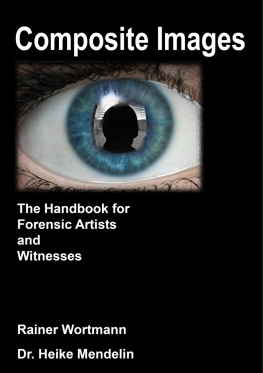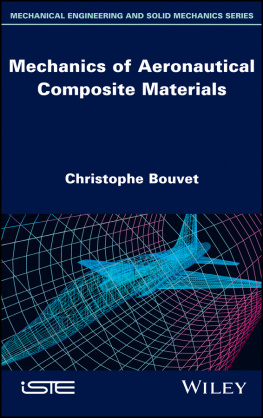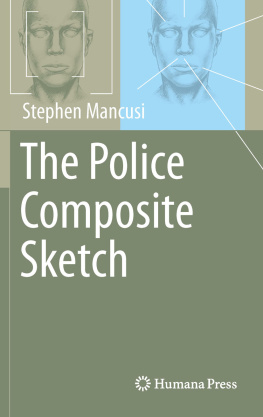The authors would like to thank their families and everybody who helped make this book reality.
We know who you are!
Bibliographic information of the German National Library:
The Deutsche Nationalbibliothek (German National Library) lists this publication in the Deutsche Nationalbibliografie (German National Bibliography); detailed bibliographic data are available on the Internet at www.dnb.de
2017 Rainer Wortmann Dr. Heike Mendelin
Manufacture and publisher:
BoD Books on Demand GmbH, Norderstedt
Translated by Helen Tate-Worch
2nd Edition
ISBN: 9783744845878
Contents
Foreword
Two investigators are talking, Have we got a description of the offender?; Even better we have a picture a composite! Now the offender has got a face!
A description of a person or an object made with only a few words is generally speaking insufficient or inexact. A facial composite means that a witnesss memory can be turned into a picture that can be shown around. The viewer now has the possibility of comparing this picture with known people or objects. Unfortunately, as a facial composite represents a subjective reproduction of a memory, it cannot be a perfect image of who or what is being looked for. However, with a good witness it is possible to achieve a high degree of similarity or to recreate individual identifying features. This makes it possible now for someone to identify who or what is being sought after and is in a position to give helpful information leading to identification.
But, how do I become a good composite sketch artist?
This book can give composite artists all the necessary knowledge and a foundation for their work. All different kinds of methods used in creating facial composites will be looked at. It is irrelevant whether the composites are created using software on a computer or drawn by hand.
Successfully creating a facial composite is just not possible without a good witness. Therefore, the second part of this book is aimed at all potential witnesses such as bank employees and sales staff and all those who would like to train their brains optimally for recognition. This section will show in a simple way how people and objects can be memorised so well that they can be visualised later.
The authors
Rainer Wortmann is a Detective Chief Superintendent in the police records department at the police headquarters in Stuttgart, Germany. He has been creating composites since 1997.
After his apprenticeship learning vehicle bodywork and employment as a truck driver at Stuttgart airport, he joined the police in 1991. After two and a half years training and four years service at the Stuttgart-Degerloch police station as a beat officer he switched to the criminal police department (equiv. Brit. C.I.D. or Amer. F.B.I.). There he was heavily involved in the development of software for digitalising the recording of interviews.
Between 2001 and 2004 he studied a degree in civil administration for upper grade police civil service at the Police College for Higher Education.
Since 2007 he has taken on the position of Facial Composite Department Coordinator for Baden-Wrttemberg. In this role he is responsible for the training, advanced training and the equipping of approx. 40 police artists. In 2009 he was elected as the Deputy Director of the National Facial Composite Work Group, which works towards trans-regional future-oriented standards of quality and collaboration.
In 2008 Rainer Wortmann successfully completed a training course at the F.B.I. Academy in Quantico, Virginia, U.S.A. to become a forensic artist (police artist). This was followed by a special Course for Ageing and Facial Reconstruction at the Anthropological Institute, University South Florida, Tampa, U.S.A. initiated by the National Center for Missing and Exploited Children.
Since 2013 he has been at the Baden-Wrttemberg Department for Criminal Investigation as a specialist for composite sketching.
D/C. Supt. Wortmann trains police artists both nationally and to a certain extent internationally for several European countries. He organises and holds conferences, appears regularly worldwide as a speaker at conferences on the subject of facial composites and maintains a constant presence in the media, on the radio and on television.
Not only that but Rainer Wortmann is also a portrait artist specialising in charcoal and graphite drawings. A selection of his works can be seen on his website www.rainerwortmann.de. Collections of his portraits are regularly presented at exhibitions and can usually be bought in support of charitable causes. In this way he supports victims of crime in addition to his normal police work.
Dr. Heike Mendelin is a qualified psychotherapist with a degree in psychology and has a doctorate in composite sketching. After her psychology degree she worked at the University of Cape Town as a lecturer and researcher establishing a long and close working relationship with the South African police in the field of composite sketching. On the one hand, her research looked at experimental studies on topics such as the cross-race effect, the recreation of the perception context for improving a composite sketch, interviewing methods. etc. On the other hand, as a result of her work with the South African police she did studies on compiling actual composite sketching, the framework and the quality of composite sketching in order to improve the quality of training police artists. Dr. Mendelin regularly presents her work at conferences.
Since 2009 she has also been working as a lecturer at the Police College for Higher Education in Baden-Wrttemberg in Germany.
In addition to her qualifications as a psychotherapist with a degree in psychology she also completed further training in the fields of relaxation techniques and interviewing. For years she has also been a hypnotherapist. Alongside her lecturing activities Heike Mendelin is currently working at her own practice as a psychotherapist with a degree in psychology.
Part I
A THE COMPOSITE SKETCH ARTIST
1 Introduction
What is a composite artist? Is it a profession? And if so, how and where can it be learned? Can anybody do it or are certain prerequisites needed? What kind of a person can create facial composites: artist, psychologist, police officer or all three together?
Composite sketches are often seen in newspapers or on television. But hardly anybody knows who has done them or how much work has gone into them. Fetch the police artist. We need to know what the offender looks like, is often heard in crime series when the criminal is unknown but there is an eyewitness.
Creating a composite sketch is not the same as the usual police questioning in which normally any investigator can interview the witness. In order to create an image according to witness statements specialists are needed. A specialist has to be able to produce something that can be shown around afterwards like a photograph. Thats what the person looks like. Does anybody know him?
2 A dream job?
When I, Rainer Wortmann, started training as a police officer, I had already heard a little bit about composite sketching. It was one of the topics relating to investigation and interviewing methods. However, I had no idea how it all worked and much less imagined that I would one day be in the position to create them myself.
My first experiences as a police officer after nearly two and half years training were made at the police station on the outskirts of Stuttgart. For four years I went out on the beat on both day and night shifts through several urban districts and dealt with road traffic collisions, calmed arguments, interviewed victims of a multitude of crimes, looked for evidence at break-ins, stopped drunk drivers, investigated environmental crimes, checked truck drivers, and much more. The main role of the uniformed beat police officer is to always be the first on scene and to carry out the first assessment. That is, to find out exactly what has happened or what could happen and to take the first essential measures. It is then the job of the criminal investigation department to carry out further investigations and to solve particularly serious crimes.
Next page









